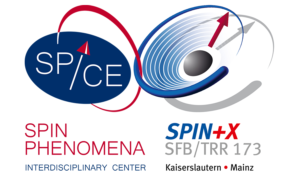On-line SPICE-SPIN+X Seminars
On-line Seminar: 24 June 2020 - 15:00 (CET)
Chiral spintronics: non collinear spin textures with application to Racetrack Memory
Stuart Parkin, Max Planck Institute of Microstructure Physics and
Martin Luther University Halle-Wittenberg, Halle

Magnetic non-collinear spin textures that have chiral structures are of great current interest. Coupled chiral domain walls in synthetic antiferromagnetic (SAF) racetracks and compensated ferrimagnets can be moved with current at very high speeds via a novel giant exchange torque1,2. When the antiferromagnetic coupling between two domain walls in a SAF racetrack is weakened unusual magnetization dynamics takes place due to chiral domain wall drag3. The same type of Dzyaloshinskii-Moriya (DMI) vector exchange interactions that stabilize chiral Néel domain walls in magnetic multilayers results in the formation of topological spin textures in bulk compounds. We recently discovered magnetic antiskyrmions in a tetragonal inverse Heusler compound Mn1.4Pt0.9Pd0.1Sn using Lorentz transmission electron microscopy (LTEM) 4. The size of the anti-skyrmion can be tuned by varying the thickness of the host material allowing for sizes varying from nanometer to microns in the same material5. This is due to long range magneto-dipole interactions that are important in this compound that has a complex DMI interaction with a symmetry that follows the D2d symmetry of its crystalline structure. The same symmetry ensures that anti-skyrmions are robust to temperature and magnetic field6. The magnetic dipole-dipole interactions also allow for the formation of metastable “elliptical skyrmions” in this same material7. These have Bloch-like boundaries that we can directly observe using LTEM. Finally, we discuss our recent discovery of novel Néel like skyrmions in a metallic compound that exist almost to room temperature and that are also tunable in size8. Chiral spin textures in ferro-, ferri- and anti-ferrimagnetic materials and thin film heterostructures are of fundamental interest with potential for spintronic applications.
PDF file of the talk available here
References
1 Yang, S.-H., Ryu, K.-S. & Parkin, S. S. P. Domain-wall velocities of up to 750 ms−1 driven by exchange-coupling torque in synthetic antiferromagnets. Nat. Nano. 10, 221-226, (2015).
2 Bläsing, R. et al. Exchange coupling torque in ferrimagnetic Co/Gd bilayer maximized near angular momentum compensation temperature. Nat. Commun. 9, 4984, (2018).
3 Yang, S.-H., Garg, C. & Parkin, S. Chiral Exchange Drag and Chirality Oscillations in Synthetic Antiferromagnets Nat. Phys. 15, 543–548, (2019).
4 Nayak, A. K. et al. Magnetic antiskyrmions above room temperature in tetragonal Heusler materials. Nature 548, 561-566, (2017).
5 Ma, T. et al. Tunable Magnetic Antiskyrmion Size and Helical Period from Nanometers to Micrometers in a D2d Heusler Compound. Adv. Mater., 2002043, (2020).
6 Saha, R. et al. Intrinsic stability of magnetic anti-skyrmions in the tetragonal inverse Heusler compound Mn1.4Pt0.9Pd0.1Sn Nat. Commun. 10, 5305, (2019).
7 Jena, J. et al. Elliptical Bloch skyrmion chiral twins in an antiskyrmion system. Nat. Commun. 11, 1115, (2020).
8 Srivastava, A. K. et al. Observation of Robust Néel Skyrmions in Metallic PtMnGa. Adv. Mater. 32, 1904327, (2020).

 Emerging phenomena, such as the spin-Hall effect (SHE), spin pumping, and spin-transfer torque (STT), allow for interconversion between charge and spin currents and the generation of magnetization dynamics that could potentially lead to faster, denser, and more energy efficient, non-volatile memory and logic devices. Present STT-based devices rely on ferromagnetic (FM) materials as their active constituents. However, the flexibility offered by the intrinsic net magnetization and anisotropy for detecting and manipulating the magnetic state of ferromagnets also translates into limitations in terms of density (neighboring elements can couple through stray fields), speed (frequencies are limited to the GHz range), and frequency tunability (external magnetic fields needed). A new direction in the field of spintronics is to employ antiferromagnetic (AF) materials. In contrast to ferromagnets, where magnetic anisotropy dominates spin dynamics, in antiferromagnets spin dynamics are governed by the interatomic exchange interaction energies, which are orders of magnitude larger than the magnetic anisotropy energy, leading to the potential for ultrafast information processing and communication in the THz frequency range, with broadband frequency tunability without the need of external magnetic fields.
Emerging phenomena, such as the spin-Hall effect (SHE), spin pumping, and spin-transfer torque (STT), allow for interconversion between charge and spin currents and the generation of magnetization dynamics that could potentially lead to faster, denser, and more energy efficient, non-volatile memory and logic devices. Present STT-based devices rely on ferromagnetic (FM) materials as their active constituents. However, the flexibility offered by the intrinsic net magnetization and anisotropy for detecting and manipulating the magnetic state of ferromagnets also translates into limitations in terms of density (neighboring elements can couple through stray fields), speed (frequencies are limited to the GHz range), and frequency tunability (external magnetic fields needed). A new direction in the field of spintronics is to employ antiferromagnetic (AF) materials. In contrast to ferromagnets, where magnetic anisotropy dominates spin dynamics, in antiferromagnets spin dynamics are governed by the interatomic exchange interaction energies, which are orders of magnitude larger than the magnetic anisotropy energy, leading to the potential for ultrafast information processing and communication in the THz frequency range, with broadband frequency tunability without the need of external magnetic fields. On-line Seminar: 10 June 2020 - 15:00 (CET)
On-line Seminar: 10 June 2020 - 15:00 (CET)



 In the time of physical distancing, it is more important than ever to remain close socially and scientifically. The Spin Phenomena Interdisciplinary Center SPICE and the Collaborative Research Center SPIN+X have joined forces to start a weekly condensed matter seminar series with an emphasis on spin and topological physics.
In the time of physical distancing, it is more important than ever to remain close socially and scientifically. The Spin Phenomena Interdisciplinary Center SPICE and the Collaborative Research Center SPIN+X have joined forces to start a weekly condensed matter seminar series with an emphasis on spin and topological physics.

